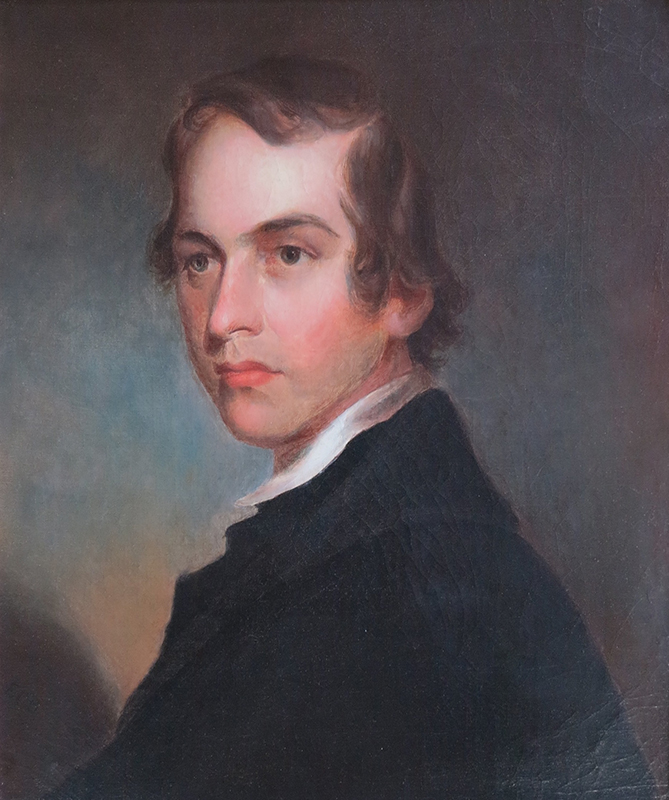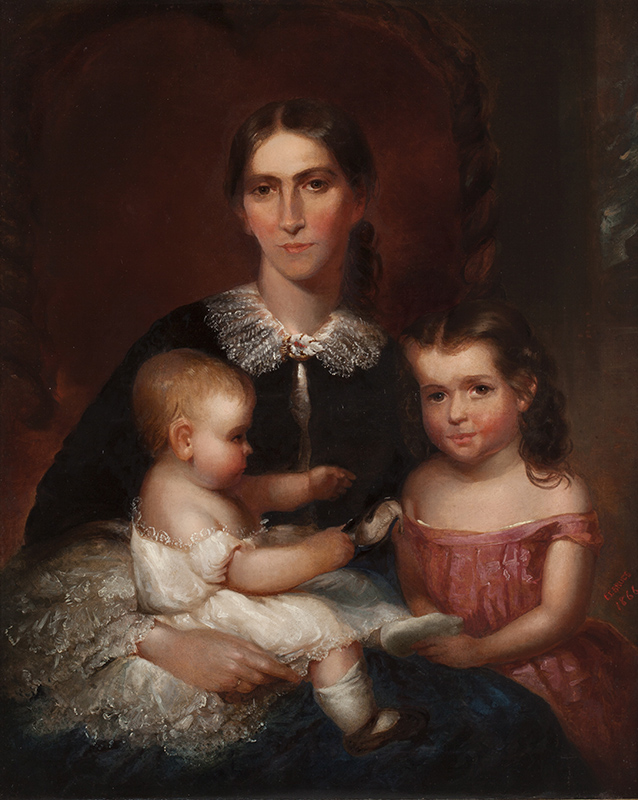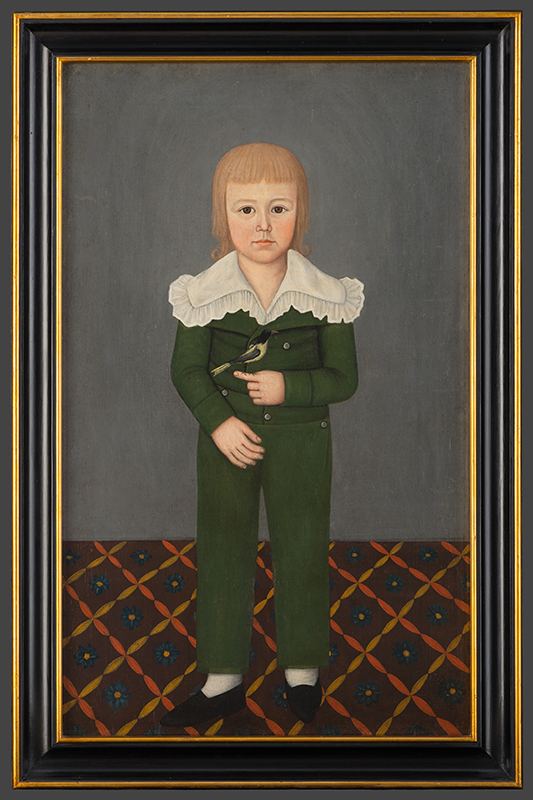Edward Caledon Bruce: A Deaf Artist in the Shenandoah Valley
by A. Nicholas Powers
The Museum of the Shenandoah Valley (MSV) in Winchester, VA, is home to one of the largest collections of works by painter Edward Caledon Bruce (1825–1900). A deaf artist, Bruce (figure 1) was among the Shenandoah Valley’s most talented native painters and over the course of his lifetime produced more than 70 paintings—mostly portraits—that survive today in institutional and private collections.
Bruce was an artist with acquired deafness. He was not born deaf but became deaf due to complications from scarlet fever contracted when he was around 14 years old. Ironically, this was about the same time that Bruce began to show a penchant for painting. Family tradition claims that while in his teens, Bruce began copying 18th-century portraits of his maternal Chesapeake ancestors (figure 2).1
Bruce was exceptionally privileged in that he came from a highly educated family with access to robust social and economic networks. His father, John Bruce (1795–1855), was a Scottish-born builder, educator, and railroad company president. His mother, Sidney Smith (1794–1874), came from a wealthy Tidewater planter family that had relocated to the fertile Virginia backcountry before the American Revolution. Some of these connections no doubt aided Bruce in his desire to become a professional painter.
According to his own recollections, Bruce traveled to Philadelphia in his late teens to study with the greatest American portraitist of the 19th century, Thomas Sully (1783–1872).2 Unfortunately, Bruce does not appear in Sully’s extensive surviving diaries.3 However, the brushwork, poses, and palette Bruce used throughout his career suggest that he did train with Sully and/or Sully’s son-in-law and protégé, John Neagle (1796–1865). At the very least, Bruce probably had access to original artworks by one or both artists (figures 3 and 4). Following his time in Philadelphia, Bruce returned to Virginia and worked largely in Winchester and Richmond until his death in 1900.
In some ways, Bruce’s early portraiture differs from that of artists deaf from birth like John Brewster Jr. of Connecticut. For deaf individuals, facial engagement and direct eye contact are essential components of communication. Correspondingly, artists like Brewster frequently painted subjects with direct and penetrative gazes. Many of Brewster’s portraits of young children (figure 5) continue the visual dialogue between subject and viewer through the adoption of standing, forward-facing poses.4
Bruce’s early portraits, by contrast, reflect his training with hearing artists like Sully and Neagle. Taking after his mentors, Bruce painted subjects in the 1840s and 1850s in a variety of angled poses with a mix of direct, semi-direct, and distant gazes (figure 3).
Over the decades that followed, Bruce increasingly painted sitters straight-on with direct gazes. A good example is his early 1860s portrait of Thomas Glass of Rose Hill (figure 6), ancestor of MSV benefactor Julian Wood Glass Jr. (1910–1992). In part, Bruce likely was responding to the rise of photography and the increased preference for forward-facing, documentary poses.
The shift also could suggest an evolution in the way that Bruce encountered the world and the people in it, including the enslaved communities of Virginia. The 1860 U.S. Slave Schedule identifies six enslaved people in the artist’s Winchester household: five owned by Bruce and one enslaved woman owned by Bruce’s widowed, live-in mother Sydney Smith Bruce.5 While much has been written about the disabling effects of enslavement on black bodies, little has been written on the interactions between enslaved individuals and deaf enslavers.6 Did Bruce’s deafness create opportunities for resistance not possible in hearing households?
Excerpts from an 1845 travel diary suggest that Bruce carried a notebook to record what he thought people said to him and to clarify what he understood. Does this imply that the enslaved individuals in the Bruce household were taught to read and write in order to fulfill their domestic roles? Fallout from Nat Turner’s Rebellion in Southampton County in 1831 resulted in severe legal restrictions on slave literacy in Virginia, but localized, lived reality was often quite different from established law. Recent excavations of the slave quarters at Belle Grove, the c. 1797 Hite family plantation south of Winchester, for example, have unearthed writing slate and pencil fragments from contexts dating to the 1830s or 1840s.7 Or perhaps, as was the case with some families in 19th-century America, the Bruce household instead developed a collection of “home signs” used to communicate between deaf and hearing family members.8 Many of the questions related to Bruce and his connections to slavery may not be answerable without additional documentary evidence. However, they demonstrate the intersectionality of enslavement, disability, and art in the Shenandoah Valley prior to the Civil War.
1 Elise Oldham Merritt, “Edward C. Bruce,” undated manuscript, Edward C. Bruce Collection (504 WFCHS), Stewart Bell Jr. Archives, Handley Regional Library, Winchester, VA. Author Elise Oldham Merritt (1891–1979) was Bruce’s granddaughter. When writing this short biography, she had access to and directly quoted from a travel diary and other primary documents that are currently unlocated but presumably still in family hands.
2 Ibid.
3 Thomas Sully Diary, 1799–1846, Thomas Sully Papers, 1792–1871 (MssCol 2926), Manuscript and Archives Division, The New York Public Library, New York, NY.
4 Harlan Lane, A Deaf Artist in Early America: The Worlds of John Brewster, Jr. (Boston, MA: Beacon Press, 2004), 86–88, 102–103.
5 Slave Schedule record for Edward C. Bruce, Winchester, Frederick County, VA, 1860, Eight Census of the United States, 1860, Series Number M653, Record Group 29, National Archives, Washington, D.C.
6 For further reading on the former, see: Dea H. Boster, African American Slavery and Disability: Bodies, Property, and Power in the Antebellum South, 1800–1860 (New York, NY: Routlege, 2013); Dea Hadley Boster, “Unfit for Bondage: Disability and African American Slavery in the United States, 1800–1860” (PhD diss., The University of Michigan, 2010); and Stefanie Hunt-Kennedy, Between Fitness and Death: Disability and Slavery in the Caribbean (Urbana, IL: The University of Illinois Press, 2020).
7 Email correspondence with archaeologist Matthew Greer, Syracuse University, December 16, 2020.
8 For a short discussion of home signs in the context of John Brewster Jr., see Paul S. D’Ambrosio, The World of John Brewster Jr. 1766–1854 (Cooperstown, NY: Fenimore Art Museum, 2006), 5.
Nicholas Powers is the Curator of Collections at the Museum of the Shenandoah Valley in Winchester, VA.
Additional portraits by Bruce—and hundreds of other objects made and used in the Shenandoah Valley from the 18th century through the present day—are available through the MSV’s recently-launched online collections portal at themsv.pastperfectonline.com.
A print version of this article was published in The Magazine of the Decorative Arts Trust, one of our most popular member benefits. Join today!






